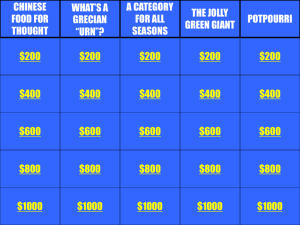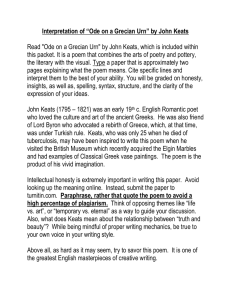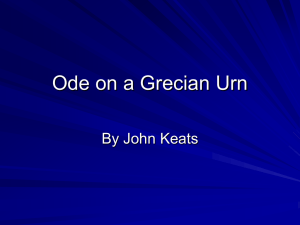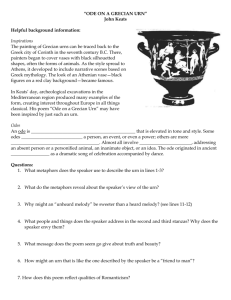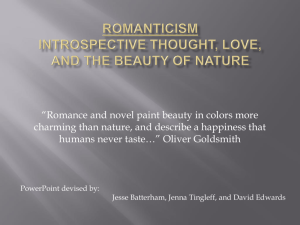Ode on a Grecian Urn - Mrs. O's Brit Lit Webpage
advertisement
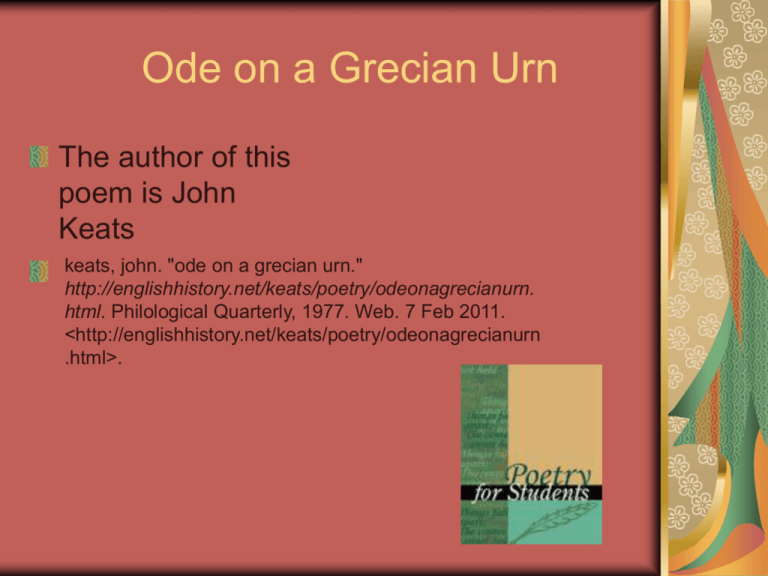
Ode on a Grecian Urn The author of this poem is John Keats keats, john. "ode on a grecian urn." http://englishhistory.net/keats/poetry/odeonagrecianurn. html. Philological Quarterly, 1977. Web. 7 Feb 2011. <http://englishhistory.net/keats/poetry/odeonagrecianurn .html>. Poem Thou still unravished bride of quietness, Thou foster child of silence and slow time, Sylvan historian, who canst thus express A flowery tale more sweetly than our rhyme: What leaf-fringed legend haunts about thy shape Of deities or mortals, or of both, In Tempe or the dales of Arcady? What men or gods are these? What maidens loath? What mad pursuit? What struggle to escape? What pipes and timbrels? What wild ecstasy? Heard melodies are sweet, but those unheard Are sweeter; therefore, ye soft pipes, play on; Not to the sensual ear, but, more endeared, Pipe to the spirit dities of no tone. Fair youth, beneath the trees, thou canst not leave Thy song, nor ever can those trees be bare; Bold Lover, never, never canst thou kiss, Though winning near the goal---yet, do not grieve; She cannot fade, though thou hast not thy bliss Forever wilt thou love, and she be fair! Ah, happy, happy boughs! that cannot shed Your leaves, nor ever bid the Spring adieu; And, happy melodist, unweari-ed, Forever piping songs forever new; More happy love! more happy, happy love! Forever warm and still to be enjoyed, Forever panting, and forever young; All breathing human passion far above, That leaves a heart high-sorrowful and cloyed, A burning forehead, and a parching tongue. Who are these coming to the sacrifice? To what green altar, O mysterious priest, Lead'st thou that heifer lowing at the skies, And all her silken flanks with garlands dressed? What little town by river or sea shore, Or mountain-built with peaceful citadel, Is emptied of this folk, this pious morn? And, little town, thy streets for evermore Will silent be; and not a soul to tell Why thou art desolate, can e'er return. Ah, happy, happy boughs! that cannot shed Your leaves, nor ever bid the Spring adieu; And, happy melodist, unweari-ed, Forever piping songs forever new; More happy love! more happy, happy love! Forever warm and still to be enjoyed, Forever panting, and forever young; All breathing human passion far above, That leaves a heart high-sorrowful and cloyed, A burning forehead, and a parching tongue. Who are these coming to the sacrifice? To what green altar, O mysterious priest, Lead'st thou that heifer lowing at the skies, And all her silken flanks with garlands dressed? What little town by river or sea shore, Or mountain-built with peaceful citadel, Is emptied of this folk, this pious morn? And, little town, thy streets for evermore Will silent be; and not a soul to tell Why thou art desolate, can e'er return. Paraphrase The Ode is a form of Lyric poem. Ode on a Grecian Urn is one of the most popular poems of Romantic poet, John Keats. It is one of the most widely read poems amongst Literature students. The poem focuses on the nature of beauty. Urns of this era are characterized by scenes from religious and musical ceremonies similar to the ones described throughout the poem. The “Ode on a Grecian Urn” portrays his attempt to engage with the static immobility of sculpture. The Grecian urn, passed down through countless centuries to the time of the speaker’s viewing, exists outside of time in the human sense. Diction Keats has a unique way of using his words in his poem. In the first stanza, the speaker stands before an ancient Grecian urn and addresses it. In the second stanza, the speaker looks at another picture on the urn, this time of a young man playing a pipe, lying with his lover beneath a glade of trees. In the fourth stanza, the speaker examines another picture on the urn, this one of a group of villagers leading a heifer to be sacrificed. It is true that the speaker shows a certain kind of progress in his successive attempts to engage with the urn. In the final stanza, the speaker presents the conclusions drawn from his three attempts to engage with the urn. He is overwhelmed by its existence outside of temporal change, with its ability to “tease” him “out of thought / As doth eternity.” Tone and Mood The prevailing mood is one of unperturbed reflection, as evinced in the opening lines' use of the words 'quietness' and 'silence'. The iambic rhythm is apparent in the first line, where the stress is on the words 'still', the syllable 'rav' in 'unravish'd', 'bride', and the syllables 'qui' and 'ness' in 'quietness', creating the impression of a heartbeat. It also becomes clear that there is a coexistence of concepts embodied in the word 'still', which carries two meanings, representing both time and motion, thus creating the impression of a frozen moment - an image which recurs throughout. The repetitious use of questions also adds suspense, the reader wishing to progress further to see if they are answered. As well as single words - the repetition of 'What' in lines 5,8,9 and 10 - whole sentence structures are also repeated in the last 3 lines, which all employ caesura (represented with a question mark), indicating that the reader should pause for effect. Suspense is also provided through the impression of escalating volume. The stanza began with a mood of meditative stillness yet finishes with the sounds of 'pipes and timbrels' Rhetorical Situation Who is the speaker in the poem: Our speaker is insecure. He keeps comparing his own verses to the urn, and he decides that they’re nowhere near as good. To whom is it addressed to: Directly to the reader. What is the author intending to communicate to the reader: The Grecian Urn depicts a world of beauty and human passions that are set in art. The Lover on the urn pictures something that cannot fade. In the poem there is a development of the idea of the supremacy of ideal art over nature since it is captured for all time on the urn it is an unchanging expression of perfection. Figurative Language All the scenes depict some form of human emotion, particularly love and desire. However, the overall theme of the poem is about the important of beauty. The figurative language in the poem illustrates Keats view the importance of beauty. Keats uses a lot of imagery from Greek culture to illustrate the importance of beauty. In the first stanza, he speaks of the places in Greece known for their beauty and serenity. He speaks of the "leaf-fring'd legend haunts about thy shape of deities or mortals, or of both, in Tempe or the dales of Arcady" (lines 5-7). According to legend, Tempe and Arcady are places where both humans and gods had the opportunity to experience the beauty of these places. Thus, Keats is showing readers that enjoying the beauty that surrounds us in not a divine privilege. Imagery Lines 1-2: The poem opens with an apostrophe, by addressing something that cannot respond. Also, the speaker uses a metaphor to compare the urn to an "unravish’d" bride and "foster-child." The urn is being personified, or treated as if it were a person who could actually get married. Line 3: Through metaphor, the urn is compared to a "sylvan historian," or someone who tells stories about forest life. Lines 41-42: The speaker praises the urn’s shape and posture and provides the image of "marble men and maidens" that form a kind of "braid." Line 44: The apostrophe and personification continues ("Thou silent form"). Lines 48-50: The urn is personified as speaking to the humans. The urn uses a simple chiasmus in the expression "Beauty is truth, truth beauty." Sound The sound of the poem is very easy and sweet. It’s a love poem which is very romantic its very detailed and he speaks with passion Perpetuation and immortality are the main themes in Ode to a Grecian Urn. The theme of perpetuation is brought up by the images where the piper got to play his song forever, the guy who could never kiss the girl under a tree yet the beauty stayed with the girl forever, the tree that would never shed its leaves etc. These all happen because all the things carved on the urn are unmoving. Structure "Ode on a Grecian Urn" consists of five stanzas that present a scene, describe and comment on what it shows, and offer a general truth that the scene teaches a person analyzing the scene. Each stanza has ten lines written in iambic pentameter, a pattern of rhythm (meter) that assigns ten syllables to each line. The first syllable is unaccented, the second accented, the third unaccented, the fourth accented, and so on. Romanticism Rhyme Scheme First Stanza: ababcdecde Second Stanza: ababcdeced Third Stanza: ababcdecde Fourth stanza: ababcdecde iambic pentameter, where each line has ten syllables In line 13, for example, he begins with a stressed syllable for dramatic effect “Not” to the sensual ear, but, more endeared Conclusion The conclusion is it’s a love poem that has lots of feelings and descriptions in it. Since it was written during the romantic period it explains the writing during this time period. The urn is the star of the show, and it is described in several different ways. In the beginning of the poem, it’s a married bride uses a metaphor to compare the urn to an "unravish’d" bride and "foster-child." Reaction My reaction to this poem was it was very sweet after I understood it. Very detailed and it had lots of imagery in the poem. I had to read it more then once because it was so long. After a couple times I understood with the help of Google.
